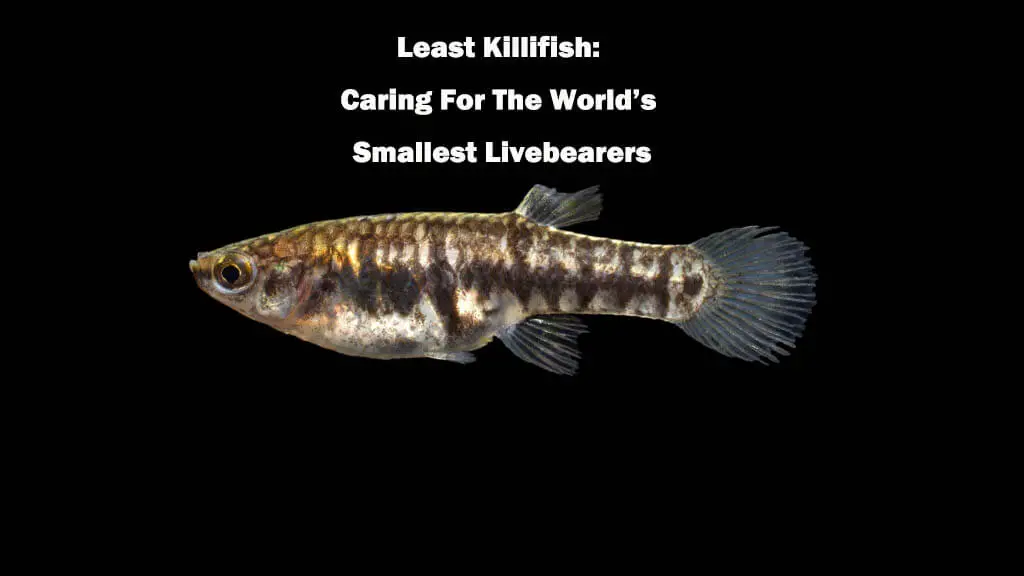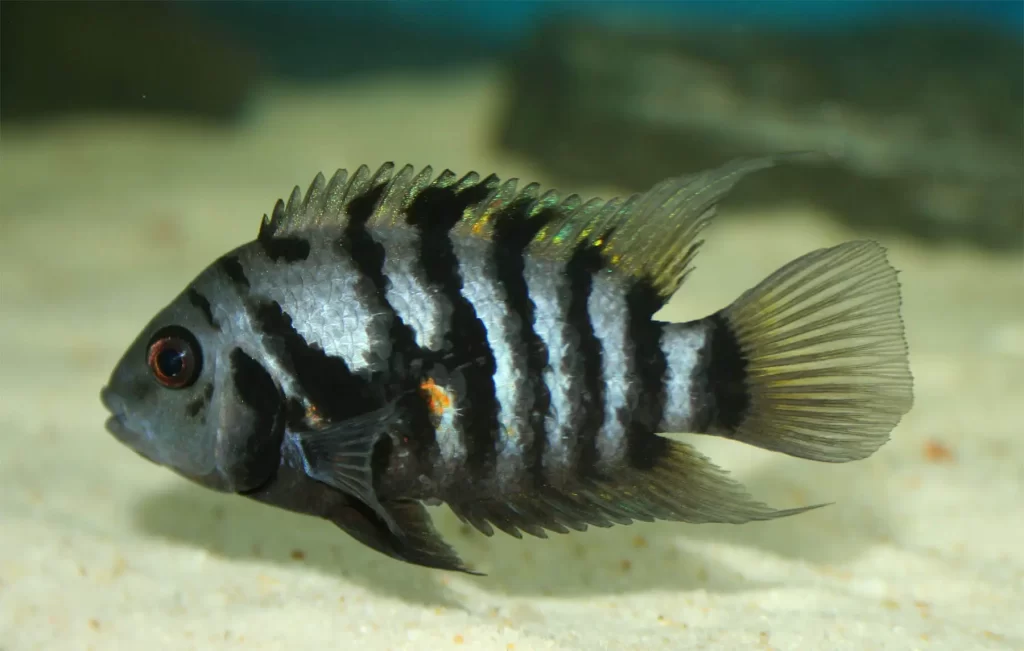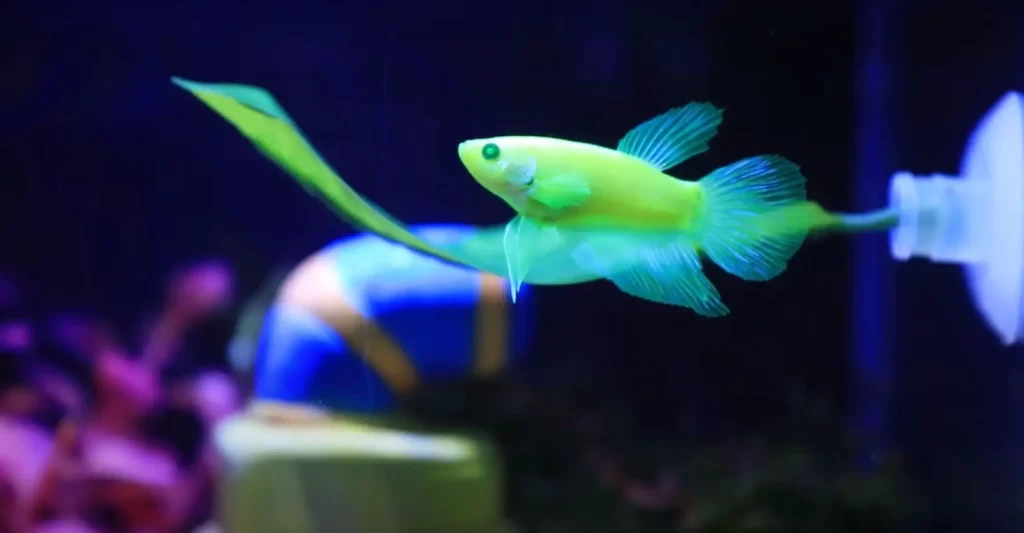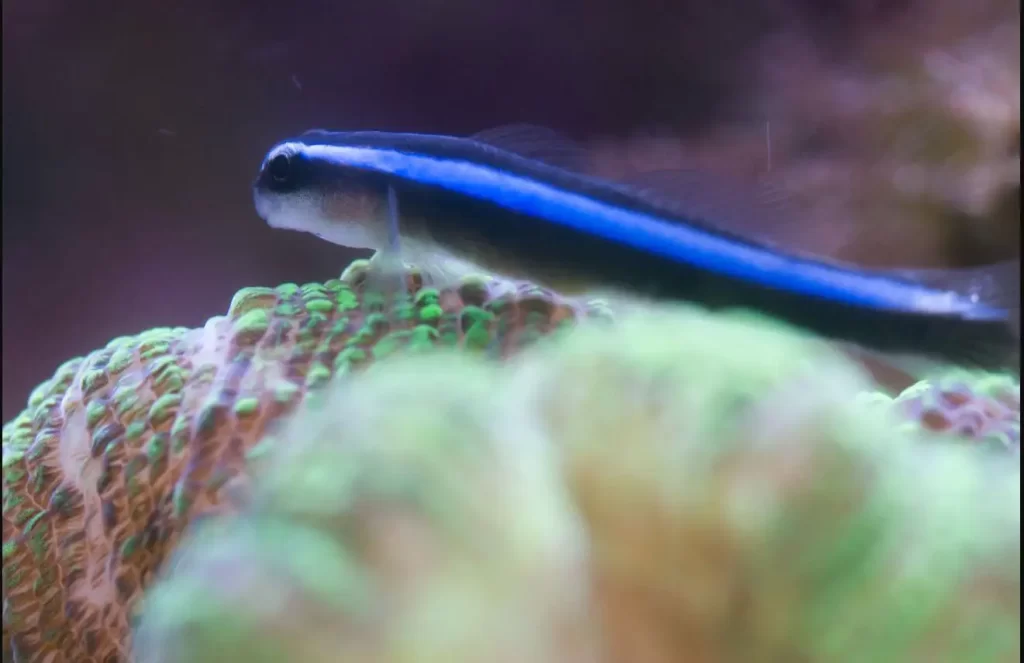Livebearer fish are some of the most popular breeds of fish among the fish parents in the world of fish keeping. As the name suggests, Livebearers do not lay eggs and give birth to the fry. These fish are peaceful, hardy, colorful, and alluring, making them a great beginner fish if you are new in the fishkeeping world. Furthermore, if you like to keep small and easy to care livebearer fish in your tank, then the Least Killifish (Heterandria Formosa) is the ideal fish. Because the Least Killifish are the smallest livebearers in the world.
The Least Killifish are small, hardy freshwater fish that are easy to take care of due to their high level of adaptability and low-level requirements. But, for better care and life quality, the requirements, including standard tank specs, diet, filtration, standard water parameters, are to be fulfilled. In addition, the Least Killifish are also easy to breed and require no special needs apart from suitable water parameters for healthy fry and breeding.
Stick around if you are interested in the Least Killifish because in this article, I am going to explain how to take care of the smallest livebearer fish in the world.
Classification of Least Killifish
The following are the details of the Least Killifish classification:
Kingdom
Least Killifish belong to the kingdom of Animalia, which is the largest kingdom in the world consisting of all the animals.
Superclass
Animals from the superclass Gnathostomata consist of jaws. The word Gnathostomata itself is derived from the Greek words “Ganathos”(jaw) and “stoma”(mouth). These vertebrates consist of the following features:
- Pelvic fins
- Jaw
- Adaptive immune system
- A horizontal semicircular canal of the inner ear
- Paired appendages
Class
The class of Actinopterygii consists of Ray-finned fish. They are a subcategory of bony fishes. Fish under this class have a bony structure supporting their webbed fins.
Order
Least Killifish are from the order of Cyprinodontiformes. Most of the fish under this order is small and freshwater fishes.
You might also like:
- How to Increase pH Level in a Freshwater Tank?
- Freshwater Aquarium Equipment Checklist
- Beginners Freshwater Fish Guide
- Beginners Guide To Installing Freshwater Sump Filter And Media To Add-In
Family
The Family of Least Killifish is from the Poeciliidae family, in which most of the fish are livebearers like guppies.
You can check out the Guppy fish care guide here.
Genus
Least Killifish are from the Heterandria genus. The fish from this genus of livebearers are mostly found in Guatemala and Mexico. Most of them look similar to the top-minnow, due to which people call them Killifish. But, in reality, they are not Killifish.
Species
Heterandria Formosa
Least Killifish Characteristics
The Least Killifish are not only the smallest fish among livebearers but also one of the tiniest fish in the world. Moreover, this Killifish has a small plump body with a rounded caudal fin and an upturned mouth. The fish has a silvery yellow body, with a light orange color on its dorsal fin, also consisting of a black dot with a yellow distal.
The Females are just about 1-inches. Whereas males can be considered the smallest vertebrates in the world. The Least Killifish have a dark lateral stripe that stretches from the snout of the fish to the caudal fin. You can also see some faint bars at the back projecting upwards at the back and sometimes downwards towards the center.
Both the male and the females have a big black dot at the base of the dorsal fin. Whereas only females consist of a dot at the anal fin.
Least Killifish are small fish, but they are lively, social, and friendly. They are hardy fish and can adapt to dynamic water parameters easily in smaller tanks, making them ideal for beginners.
If you are a beginner, you may also like our article on The 8 Simple Step Process On How To Set Up a Fish Tank For Beginners.
Natural Habitat Of Least Killifish
Predominantly Least Killifish are freshwater fish, but they can also survive in the brackish waters. They are found in the blackwater habitat in the southern pine hills and Coastal lowlands of Alabama, filled with heavy vegetation.
Least Killifish’s natural diet consists of microcrustaceans and occasionally plant materials. They usually feed in the daytime on the surface, due to which they are easily visible, and you might be tempted to collect them. But, I recommend not to add the wild bunch to your aquarium due to the probable presence of parasites in the fish.
Still, if you want to collect them despite the risk, then I suggest you be well-packed with a stock of medicines related to the Killifish.
How To Properly Take Care Of Least Killifish?
As mentioned before, Least Killifish is a very easy breed of fish to take care of, making them an ideal beginner fish. When you just start fishkeeping, you are unknown to much basic information required to make the fish keeping successful.
This is the condition where fish like Least Killifish are suitable. Because due to their hardiness, the probable mistakes the beginners make in their initial days will not have adverse effects on the fish.
You might find these articles interesting:
- Easiest Fish to Breed in Home Aquarium | Make Profit
- 20 Health Benefits of Keeping an Aquarium Fish At Home Or Office
However, this does not mean the fishkeeper, old or new, should ignore the requirement of quality life and environment for any fish, including Least Killifish.
As a result, in this segment of the article, I am going to explain how to properly care for the Least Killifish. So, without further ado, let us jump right into the topic itself.
Tank Setup
Due to their tiny size, you can keep the Least Killifish in a small-sized tank. The fish can thrive in most of the tank conditions, but the minimum tank requirements still need fulfillment. If you plan on keeping your fish alone, then a tank size of 5-gallon is well recommended due to their size.
However, if you plan to keep a community of Least Killifish or with some tankmates, then a tank of 10-gallon is recommended or a bigger tank. But, I strongly suggest keeping these fish in a small tank. They have difficulty locating their food in a large tank environment.
The best 5 to 10-gallon fish tank that I recommend is GloFish Crescent Aquarium Kit 5 Gallons, which Includes Hidden Blue LED Light And Internal Filter.
Furthermore, you will not need any heaters in the tank as Least Killifish do well at room temperature. The fish are not jumpers, so you will not need an aquarium lid. But, you can put some proper decors and plantations inside the tank of which I will talk about in detail in the segments below.
Water Conditioning
As mentioned before, the Least Killifish can thrive at room temperature. Precisely speaking, a room temperature of 68 to 80 °F is extremely suitable for them to thrive. But, they can also out hold against some harsh temperatures ranging from 50 to 90 °F.
The water temperature above the range of 90 °F can lead to a serious imbalance in the sex ratio of the fish. Due to their ability to thrive at room temperature, you might not need a heater, but still, it might be useful in the winter seasons.
hygger 50W Mini Submersible Digital Display Aquarium Heater would be best for Small Fish Tank, Compact and Fast Heating Thermostat, with External Controller and Built-in Thermometer.
For the hardness of the tank water, you should keep it in the range of 5 to 20 dKH and a pH level of 6.5 to 8.0. Moreover, if you use hard alkaline water for the aquarium, then it is well recommended to add some sea salt along with some de-chlorinator. Some experts claim Least Killifish live healthy in saltwater.
Learn more about the following:
Best Plants and Decors
Well, any type of aquarium plant is compatible with the Least Killifish. But, if you as a fishkeeper are planning to breed a colony, then the following plants are bushy and will be ideal for your convenience.
Java Moss
Most of the aquarium plants need a certain level of care for their growth. But, believe me, Java Moss does not need any care for its growth and needs a temperature ranging from 59 to 86 °F, a pH level of 5.0 to 8.0, and a water hardness of 3 to 12 dKH.
It is a strong plant that grows at a considerable pace. These plants will make thick, lush mos carpets, which are very suitable for the fry. You can get more information on Java Moss Care.
Hornwort
The Hornworts are bushy plants that can thrive in any environment, but not the ones below the freezing point. It grows very fast if left floating on the water, but can also be planted as per your convenience.
Hornworts needs a temperature between 63 to 86 °F of the water temperature to grow. Besides, they require a pH level of 5.0 to 8.0 and water hardiness of 2 to 25 dKH.
Cabomba
Cabomba is a little difficult to grow in the aquarium. Contrastingly, some experts consider these plants invasive in the wild. They need proper lighting for their longer growth.
But if you are able to properly grow this plant, you will have a little green forest in your aquarium, which seems very attractive. This plant needs a water temperature of 72 to 82 °F, a pH level of 6.5 to 7.5, and a water hardness of 3 to 12 dKH.
Guppy Grass
Guppy grasses are fast-growing plants and aids in controlling ammonia, nitrates, and nitrite. Furthermore, it adds the needed depth of greenery in your tank, making an ideal cover for the fry.
But, you need to supervise the growth of this plant due to its fast-growing nature. Guppy grass needs a water temperature of 50 to 86 °F, a pH level of 6.0 to 7.0, and water hardiness of 2 to 25 dKH.
Water Wisteria
Water Wisteria is a fast-growing plant suitable for aquariums. They help to keep the nitrate, ammonia, nitrites, and cyanobacteria under control and also consists of anti-microbial properties.
In addition, these plants provide great shelter and protection for the fry. Besides, they need a water temperature of 64 to 86 °F, a pH level of 5.0 to 8.0, and water hardiness of 2 to 25 dKH.
Whereas, in the case of decors for your aquarium tank, Dragon stones are the fancy option. They are a good choice for the substrate as well and are easily available at cheap prices in stores. Otherwise, normal river stones work a charm as well.
Aquatics Aquarium Ohko Dragon Stone Rock Mixed Sizes is the best in the market.
Stocking
Stocking the Least Killifish is mainly done by the fishkeepers for creating a breeding colony. So, if you want to stock, then you would probably want more females than the males for breeding and increasing the numbers.
The males get a little competitive with each other for the females, but the competition will not result in bodily harm to the fish.
Best Tank Mates For Least Killifish
Least Killifish are naturally found among many species of fish in the same environment. Due to this, the fish mentioned as the tank mates in the following segment is the same fish found along the Least Killifish in the natural environment.
The following is the list of the best tank mates for The Least Killifish:
- Pygmy Sunfish (Elyssoma SP)
- Bluefin Killi (Lucania goodie)
- Emerald Dwarf Rasboras (Microrasbora Erythromicron)
- Swamp Darter (Etheostoma fusiforme)
- Rosy Loach (Petruichthys sp. ‘Rosy’)
- Cherry Barb (Puntius titteya)
- Scarlet Badis (Dario Dario)
Apart from the above-mentioned fish, small fish with peaceful and quiet nature can easily be paired with the Least killifish in an aquarium.
But, there is the exception of shrimps and big fish because Least Killifish are known to prey on the small shrimps, while some of the shrimps, like ghost shrimps, prey on Least killifish. On the other hand, due to the small size of Least Killifish, they can be eaten by the bigger fish, so better not put big fish in the same tank as the Least Killifish.
Feeding And Diet
The Least Killifish are not picky in any way when it comes to feeding. They are omnivores and small in stature. Due to this, they need a small-sized mixed diet. Mainly, live foods go down very well with these tiny guys. The following is the loss of live food diet you can feed your Least Killifish with recommendations of the best products:
- Baby brine shrimp: Ocean Nutrition Instant Baby Brine Shrimp 0.7-Ounces (20 Grams) JarBrine shrimp
- Mosquito larvae: Exotic Nutrition Bulk Dried Black Soldier Fly Larvae (10 lbs.) – High-Calcium Insect Treat
- Small daphnia: 1000+ Live Daphnia Magna
- Wingless fruit flies: Josh’s Frogs Melanogaster Fruit Fly Culture Kit (Makes 10 Cultures)
- Small harvested worms: 9 OZ Matured Micro worm Mega Culture – Ready to Harvest – Live Fish Food
The live foods will not only keep your fish healthy, but it will also help to bring out more of the fish’s color.
Similarly, you can also feed frozen, plant-based food and some of the dried food to you, Least Killifish. But, you should avoid flakey foods because they will not do enough to provide the needed nutrition.
The important thing you should look out for in these kinds of food is the micron level. The adult Least Killifish can eat around 800 microns, while the fry should eat around 200 microns immediately after they are born. The following is the list of some of the frozen and dried foods.
- Golden Pearls: Aquatic Foods Inc. AFB Golden Pearls, 5-50 Microns Golden Pearls for Corals, Reef Tanks, Fry & Babies.1/8-lb
- Freeze-dried brine shrimp: Omega One Freeze Dried Brine Shrimp, 1.28 oz
- Decap brine shrimp eggs: Brine Shrimp Egg, Technical Grade 80% HR, 16 oz Can
- Copepods: Atlantic 3000+ Live copepods Tisbe biminiensis 8oz
- Frozen bloodworms: SAN FRANCISCO BAY Brand Freeze Dried Bloodworms 1.75oz
- Frozen Mysis shrimp: San Francisco Bay Brand Freeze Dried Mysis Shrimp 3.35oz
- Cobalt fry food: Cobalt Aquatics25142Ultra Guppy Nano Bits Floating .6mm 6 oz, Natural
- Freeze-dried blackworms: Aquatic Foods Inc. Blackworms, Loose Freeze Dried California Blackworm 10gram
Lighting And Filtration
The Least Killifish are pretty adaptive fish when it comes to lighting. But, the subdued lights can be easily installed on their tank. You can even use the installed plants to provide the subdued effect. The Least Killifish, unlike many others, is pretty brave and do not easily get spooked.
As the Least Killifish appreciate the slow-moving water, so a sponge filter or a simple air pump are well recommended to use. If you are having trouble while choosing a brand, then the following are some of the good brands of sponge filters:
- Hikari sponge filters
- Zeiss bubble filter
- Any simple Air pump
What Are The Health Problems Of Least Killifish?
Now, the Least Killifish are hardy and tough fish, but they are not invincible; hence they can be prone to some pop-up diseases and infections now and then. So, the following are some of the diseases of the Least Killifish, along with their causes and medications.
Tapeworm
Tapeworms are a type of small flats worms that infest and live in the intestine of the fish. The infestation of these worms is hard to get rid of.
Also, you will see these worms coming out of your fish’s anus or on their feces/poop.
The following are the causes, symptoms, and medication or cure of and for the tapeworm infestation are as follows:
Cause Of The Tapeworm Infestation
- tapeworms infested food
Symptoms Of The Tapeworm Infestation
- Inability to grow
- Sunken stomach
Medications Or Cure For The Tapeworm Infestation
- Fenbendazole
- Levamisole
- Praziquantel
Fungal Infection
Fungal Infection is quite rare in fish in comparison to parasite and bacterial infections. You can have a hard time distinguishing it from a bacterial infection.
The general appearance of a fungal infection is white cottony growth on fish, which can be internal as well.
The following are the causes, symptoms, and medication or cure of and for the fungal infection are as follows:
Causes Of Fungal Infection
- Open wounds
- Poor water quality
- Infected food
- Stress
Symptoms Of Fungal Infection
- Cottony growths on body, gills, fins, or eyes
Medication Or Cure For Fungal Infections
- Levamisole
- Metronidazole
- Praziquantel
- Nitrofurazone
- Erythromycin
Skin And Gill Flukes
Skin and gill flukes are parasites similar to worms that are firmly attached to the fish. Since they are parasitic, they are extremely difficult to see on the fish. Due to this, they are hard to diagnose.
But, the good news is they are common and present in almost every aquarium and are not of a high-level danger.
The following are the causes, symptoms, and medication or cure of and for the skin and gill flukes are as follows:
Causes of the Skin and Gill Flukes
- Stress
- Wrong water parameters
- Overcrowding
Symptoms Of Skin And Gill flukes
- Itchiness
- Hard Breathing
- Excessive mucus on the skin
- Redness on the gills and skin
Medication Or Cure For The Skin And Gill Flukes
- Formalin
- Sea salt
- Organophosphates
- Praziquantel
- Mebendazole
- Toltrazuril
Bacterial Infection
Bacteria have different types and have a large family, each consisting of varying symptoms. The infection is also sometimes referred to as fin and tail rot. They often occur after a parasitic infestation or physical injury. Furthermore, your fish can have internal, external, or both types of bacterial infection.
The following are the causes, symptoms, and medication or cure of and for the bacterial infection are as follows:
Causes Of The Bacterial Infection
- Poor water quality
- Inappropriate water parameters
- Stress
- Bad old food
Symptoms Of The Bacterial Infection
- Fuzzy growths
- Bloating
- Pop-eye
- Red Streaks
- Red ulcers
Medication Or Cure Of The Bacterial Infection
- Amoxicillin
- Erythromycin
- Ciprofloxacin
Cotton Mouth Disease
Also known as Columnaris disease or false neon tetra disease, cotton mouth disease can be seen in Leas Killifish. This disease occurs in the mouth of the fish but can also be seen in some body parts.
The following are the causes, symptoms, and medication or cure of and for the cottonmouth disease are as follows:
Causes Of The bacterial Infection
- Gram-negative bacterium
- Flavobacterium columnare
Symptoms Of The Bacterial Infection
- Grey spots
- Lesions on the back and around the mouth
- Discolored scales
- Fuzzy patches due to secondary infection
Medication Or Cure Of The Bacterial Infection
- Copper sulfate
- Acriflavine
- Furan
- Terramycin (most effective)
How To Properly Breed Least Killifish?
So, in this part of the article, I will be explaining about breeding Least Killifish. So let us jump right into the matter we have ahead.
Believe me! The Least Killifish are one of the easiest fish to breed. You are just required to provide the right water parameters and in the tank, and the breeding will naturally occur. Also, the Least Killifish are better breeders when in a colony situation.
Spawning Of Least Killifish
The spawning process in the Least Killifish happens in a flash, due to which you can have difficulty seeing it in detail.
Much like in all the livebearers, the male deposits its sperm into the female through its gonopodium. Furthermore, the sperms will fertilize the eggs inside the female, and the fry will grow inside the female until it hatches.
Birth And Fry Care
Generally, the female Least Killifish can be pregnant with as much as 40 fries. Females take up to 10 to 14 days to release all the fry in the water, but sometimes it might take up to 4 weeks for all the fry to be released.
The reason for this longer birth period is not all the fetuses of the fry will be ready to hatch at the same time. This process of multiple fetuses in the different development stages in the same womb is called superfetation.
Due to superfetation, the size of the fry becomes bigger; as a result, females are able to release only 1 or 2 fry in a day. Furthermore, the fry of the Least Killifish are very active and can easily take care of themselves.
The parent fish do not harm the fry, due to which you will not have to separate the parents from the fry. But, the tankmates of Least Killifish may be tempted to prey on the fry. The plants, as mentioned above, will provide the necessary shelter to the fry, due to which it is necessary to have a sufficient plantation in the tanks.
Learn more about how to set up a fry tank from here.
Frequently Asked Questions
Can The Least Killifish Prey On Other Fish?
No, Killifish are calm and peaceful omnivore fish. They are well compatible with other small non-violent fishes and will not prey on others. However, they are known to prey on small shrimps. So, better not put both together in the same aquarium.
How Large Should The Size Of The Least Killifish Be In The Starting Phase Of Keeping?
Well, the Larger the stock, the better, but up to the limit of the size of your aquarium. The reason behind needing a considerably large stock of Least Killifish is due to the probable reduction in the male’s reproductive performance. Moreover, the maturation period of the offsprings and its feasibility can also reduce.
Conclusion
Despite having “kill” in their name, the Least Killifish is the perfect aquarium subject for all you beginner and veteran fish parents. Furthermore, if you are a busy individual and lack sufficient time for your pets, then the Least killifish are your go-to fish due to their low maintenance need.
These fish are well appreciated among the fishkeeper community for their ease of care and breed. Most people love them for their tiny size, as they can even thrive in small-sized aquariums and for their colors too. They are good colonial fish, due to which they are a joy to look at together in the aquarium.
Due to their hardiness, they are tough and can adapt to different water parameters. But, for them to have a healthy and quality life, the standard temperature and water parameters should be maintained.
As per their nature, they are compatible with most of the fish in an aquarium as long as the other fish are small and peaceful. Otherwise, they tend to become prey to large and aggressive fish.
Thank you for being a part of this reading journey and if you have any further inquiries, feel free to mention them in the comments below.
Related articles:






